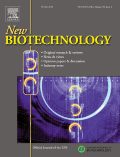
Bioresources and Bioprocessing
Scope & Guideline
Innovating Bioprocessing for a Greener Tomorrow
Introduction
Aims and Scopes
- Bioconversion of Biomass:
Research focused on the transformation of various biomass sources into biofuels, biochemicals, and biopolymers, utilizing microbial and enzymatic processes. - Bioprocess Engineering:
Studies investigating the optimization of bioprocesses, including fermentation, extraction, and purification methods to enhance yield and efficiency in the production of bio-based products. - Sustainable Waste Management:
Exploration of methods to convert agricultural and industrial waste into high-value products, addressing environmental concerns while promoting resource recovery. - Microbial Biotechnology:
Investigations into the application of engineered microorganisms for the production of valuable metabolites and bioproducts, including enzymes, acids, and pharmaceuticals. - Innovative Extraction Techniques:
Development of advanced extraction methodologies, such as enzymatic and solvent-based processes, to isolate bioactive compounds from natural sources. - Environmental Biotechnology:
Research emphasizing the role of biotechnological approaches in environmental remediation and the sustainable management of resources.
Trending and Emerging
- Metabolic Engineering:
An increasing number of studies are focusing on metabolic engineering techniques to enhance the production of high-value compounds from microorganisms, reflecting a trend towards precision biotechnology. - Biorefinery Approaches:
Research on integrated biorefinery systems that convert biomass into multiple products is gaining traction, highlighting the importance of resource efficiency and sustainability. - Synthetic Biology:
The application of synthetic biology to design and construct new biological parts, devices, and systems for improved bioprocessing is emerging as a significant theme. - Waste Valorization:
There is a growing emphasis on the valorization of agricultural and industrial waste, transforming them into biofuels, chemicals, and materials, showcasing a commitment to circular economy principles. - Nano- and Biotechnological Innovations:
Recent papers reflect an increasing interest in the use of nanotechnology in bioprocessing, particularly for enhancing enzyme activity and improving product recovery. - Bioinformatics and Computational Tools:
The integration of bioinformatics and computational tools in the design and optimization of bioprocesses is becoming more prevalent, indicating a trend towards data-driven research.
Declining or Waning
- Traditional Fermentation Processes:
Research papers focused on conventional fermentation methods have become less frequent, possibly due to the shift towards more engineered and optimized bioprocessing techniques. - Single-Strain Biocatalysis:
There is a noticeable reduction in studies that emphasize the use of single microbial strains for biocatalysis, as multi-strain or consortia approaches gain traction for enhanced efficiency. - Static Cultivation Systems:
The exploration of static cultivation systems for microbial growth has waned, with a growing preference for dynamic and controlled bioreactor systems that offer better scalability and yield. - Non-engineered Natural Products:
Research focusing on the extraction and application of non-engineered natural products has decreased, as the emphasis shifts towards biotechnological modifications and enhancements. - Non-sustainable Practices:
There has been a decline in research related to non-sustainable practices in biomass utilization, reflecting a broader trend towards sustainability in bioprocessing.
Similar Journals

BIOTECHNOLOGY LETTERS
Exploring the Cutting Edge of Biotechnological AdvancementsBIOTECHNOLOGY LETTERS is a prestigious peer-reviewed journal that has been at the forefront of biotechnology research since its inception in 1979. Published by Springer, this esteemed journal serves as a vital platform for disseminating cutting-edge research in the fields of applied microbiology, bioengineering, and biotechnology, with a focus on innovative methodologies and technologies. With an impact factor reflecting its critical contribution to the discipline, BIOTECHNOLOGY LETTERS resides in the Q2 and Q3 tiers of various scientific categories, placing it among the notable journals in the biotechnological landscape. Although it offers traditional access options and does not feature open access, the journal embraces a global readership, encouraging submissions from researchers, professionals, and students eager to explore the dynamic advancements in biotechnology. Situated in the Netherlands, it continues to shape the future of the field through relevant, impactful research that addresses contemporary challenges and opportunities in medicine and beyond.

Processes
Igniting collaboration in bioengineering and process technology.Processes is an esteemed open-access journal published by MDPI, dedicated to advancing the understanding and application of scientific principles within the realms of bioengineering, chemical engineering, and process chemistry and technology. Founded in 2013 and based in Basel, Switzerland, this journal aims to foster rigorous research dissemination without the barriers of traditional publishing, making a diverse array of scholarly articles accessible to the global scientific community. With an impressive standing in the academic landscape, Processes is classified in 2023 within prestigious quartile rankings, including Q2 in Chemical Engineering (miscellaneous) and Q3 in both Bioengineering and Process Chemistry and Technology, reflecting its relevance and contribution to these dynamic fields. The journal welcomes submissions that not only present innovative methodologies and experimental findings but also encourage interdisciplinary collaboration and knowledge sharing among researchers, professionals, and students. As of recent metrics, it ranks favorably within Scopus, reinforcing its impact and relevance for ongoing research and development in these disciplines. Explore Processes as a source of inspiration and knowledge for your next scientific endeavor.

Biotechnology Journal
Connecting researchers to the latest breakthroughs in biotechnology.Biotechnology Journal, published by WILEY-V C H VERLAG GMBH, stands at the forefront of biotechnological research and innovation, recognized for its significant contributions to the fields of applied microbiology, molecular medicine, and broader biotechnology. With its ISSN 1860-6768 and E-ISSN 1860-7314, this journal has achieved impressive 2023 quartile rankings, positioning itself in Q1 for both Applied Microbiology and Biotechnology and Medicine (miscellaneous), and Q2 in Molecular Medicine, showcasing its impact and relevance within the scientific community. Based in Germany, the journal aims to disseminate high-quality research that drives advancements in biotechnological applications, fostering a platform for researchers, professionals, and students to engage with cutting-edge developments. With its ongoing commitment to excellence, the Biotechnology Journal is an essential resource for those seeking to stay informed about the latest trends and innovations in biotechnology.

Biotechnology for Biofuels
Advancing sustainable energy through innovative biotechnology.Biotechnology for Biofuels, published by BMC in the United Kingdom, stands at the forefront of renewable energy research. As an open-access journal since 2008, it has become a critical platform for sharing innovative research and developments in the field of applied microbiology and biotechnology, particularly in the sustainable production of biofuels. With an impressive 2023 ranking of Q1 in multiple categories—including Applied Microbiology and Biotechnology, Biotechnology, and Management, Monitoring, Policy and Law—this journal offers unparalleled visibility and accessibility for your work. Its Scopus metrics underscore its influence, with rankings in the top 10% across several categories, emphasizing its integral role in advancing research on environmental sustainability and bioenergy solutions. Researchers, professionals, and students alike will find in this journal a rich resource for current studies, methodologies, and policies essential for navigating the complex landscape of biofuel technology.

JOURNAL OF BIOSCIENCE AND BIOENGINEERING
Connecting researchers to the pulse of bioscience advancements.The JOURNAL OF BIOSCIENCE AND BIOENGINEERING, published by the SOC BIOSCIENCE BIOENGINEERING JAPAN, is an esteemed peer-reviewed journal dedicated to advancing knowledge in the fields of applied microbiology, biotechnology, and bioengineering. With its ISSN of 1389-1723 and E-ISSN 1347-4421, this journal has been providing a platform for innovative research since its inception in 1991, maintaining its relevance through periodic updates and a scope that encompasses various aspects of bioscience and engineering. The journal boasts a notable impact factor, reflecting its contributions to the Q2 and Q3 quartiles in relevant categories as of 2023, which positions it amongst the well-regarded publications in its field. Researchers and professionals can access its rich archive through open access options, ensuring wide dissemination of pivotal studies. With its address rooted in Osaka University, Japan, the journal serves as a vital resource for scientists and scholars committed to pushing the boundaries of biosciences and engineering.

New Biotechnology
Exploring New Horizons in Life SciencesNew Biotechnology, published by Elsevier, is a distinguished academic journal focused on the innovative realms of biotechnology and bioengineering. With an impact factor reflecting its strong presence in the field, this journal serves as a vital resource for researchers and professionals in the life sciences, offering insights into cutting-edge advancements and applications in biotechnology, molecular biology, and related disciplines. The journal's open access policy enhances its accessibility, allowing broad dissemination of knowledge and research findings. With a robust set of Scopus ranks placing it in the top tiers of its categories, including rank #36 in Biotechnology and #24 in Bioengineering, New Biotechnology represents a critical platform for scholars aiming to contribute to the ongoing dialogue in these rapidly evolving fields. Since its inception in 2008 and continuing through to 2024, the journal remains committed to fostering innovation and collaboration among scientists dedicated to advancing biotechnological applications, thereby significantly impacting medicine and industry.

BIOTECHNOLOGY AND BIOPROCESS ENGINEERING
Driving Innovation in Bioprocess TechnologiesBIOTECHNOLOGY AND BIOPROCESS ENGINEERING, published by the Korean Society for Biotechnology and Bioengineering, is a prominent journal in the fields of applied microbiology, biotechnology, bioengineering, and biomedical engineering. Since its inception in 1996, this journal has served as a vital platform for researchers and professionals, facilitating the dissemination of cutting-edge research and innovative applications related to bioprocesses and biotechnology systems. With an ISSN of 1226-8372, this journal is ranked within the Q3 quartile across several categories, demonstrating its relevance and impact in the academic community. Although it operates under traditional access modalities, the journal strives to provide quality and timely insights into the advancements in bioprocess technology and microbial applications, fostering a collaborative environment for knowledge exchange. Notably, it is indexed with a respectable presence on Scopus, making it a valuable resource for students and professionals seeking the latest developments in biotechnology. For more details, kindly refer to the Korean Science Technology Center, #704 Yeoksam-Dong, Gangnam-Ku, Seoul 135-703, South Korea.

ChemBioEng Reviews
Exploring the Synergy of Chemistry and BiologyChemBioEng Reviews is a premier academic journal dedicated to advancing the fields of biochemistry, bioengineering, and chemical engineering. Published by WILEY-V C H VERLAG GMBH, this journal serves as an essential platform for researchers and professionals seeking to disseminate groundbreaking insights and innovations. With a remarkable impact factor and a solid reputation, it is ranked in the top quartile (Q1) across multiple disciplines, including Biochemistry, Bioengineering, and Industrial and Manufacturing Engineering. The journal's comprehensive scope covers the synthesis, analysis, and application of bioengineered solutions, making it a vital resource for anyone involved in process chemistry and technology. With an unwavering commitment to high-quality scientific discourse from 2014 to 2024, ChemBioEng Reviews is not only pivotal for the academic community but also contributes to industry advancements in filtration, separation processes, and the intersection of chemical and biological engineering.

PREPARATIVE BIOCHEMISTRY & BIOTECHNOLOGY
Advancing biochemistry and biotechnology for a healthier tomorrow.PREPARATIVE BIOCHEMISTRY & BIOTECHNOLOGY, published by Taylor & Francis Inc, serves as a vital platform for advancing research in the fields of biochemistry, biotechnology, and related areas of medicine. With an ISSN of 1082-6068 and an E-ISSN of 1532-2297, this journal has established itself with a notable Q3 ranking in the 2023 categories of Biochemistry, Biotechnology, and Miscellaneous Medicine, reflecting its relevance and contribution to these disciplines. The journal encompasses a wide range of topics, providing crucial insights into preparative methods, innovative biotechnological applications, and their implications for various medical advancements. Although not open access, the journal's rich content is crucial for researchers and professionals aiming to stay abreast of the latest developments and methodologies in biochemistry and biotechnology. With an enduring commitment to excellence since its inception in 1996, the journal remains an essential resource for academics and practitioners dedicated to advancing scientific knowledge and practical applications.

JOURNAL OF INDUSTRIAL MICROBIOLOGY & BIOTECHNOLOGY
Fostering Knowledge and Innovation in Microbial ApplicationsJOURNAL OF INDUSTRIAL MICROBIOLOGY & BIOTECHNOLOGY, published by Oxford University Press, is a vital resource for researchers and professionals actively engaged in the fields of applied microbiology, biotechnology, and bioengineering. With an ISSN of 1367-5435 and E-ISSN of 1476-5535, this journal has established itself as a leading platform for disseminating innovative research findings and advancing knowledge in industrial microbiology since its inception in 1996. As of 2023, it is classified in the Q2 quartile across multiple categories including Applied Microbiology and Biotechnology, Bioengineering, and Medicine, underscoring its significance in the academic community. Notably, it ranks 26th of 127 in Applied Microbiology and Biotechnology, placing it in the 79th percentile, indicative of its high impact and influence. Although it does not currently offer Open Access, it remains a key outlet for high-quality scholarly articles that align with the objectives of improving industrial practices through biotechnological applications. For those interested in the latest developments and methodologies within the realm of applied microbiology and biotechnology, this journal serves as an indispensable reference.